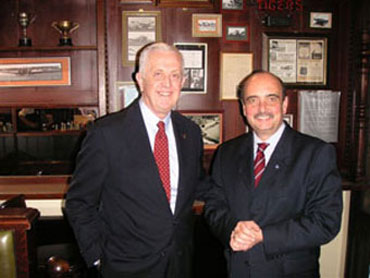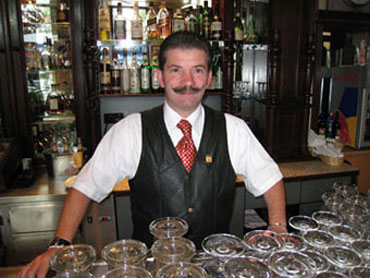Cargo City Süd Hotel Is A Dream
“There’s
a small hotel-
“With
a wishing well-
“I wish
that we were there-
“Together.”
I have always loved small hotels. Those
sweet and simple lyrics are from a Rogers & Hart song about a place
in Bucks County, Pennsylvania.
Unfortunately, finding a great small hotel
near any airport in the 21st Century is near to impossible.
However, there is one near a cargo area
in Europe that I’m reluctant to write about, because I don’t
want it to get too famous as that will surely lead to change.
There is a spot just off the main runways
at Fraport. In that spot, the U.S. Air Force once utilized Rhein Main
as a military base to support U.S. activities in Europe, Africa, the Middle
East and South East Asia, and a logistics hub for troops, dependents and
all kinds of airfreight.
Today, the area is referred to as Cargo
City Süd.
The small hotel is called “InterCity
Airport Hotel.”
 |
 |
Mr. Wüstefeld (right in picture on left) is shown with ACNFT
publisher Geoffrey Arend inside the hotel's neat little memorabilia-packed,
vest pocket saloon called JU52. Harri (in picture left) welcomes customers
to JU52.
Once upon a time, in the late
1940’s, this place served as a stopover spot for families traveling
back and forth across the pond.
The building itself was once a billet for
pilots that flew the Berlin Airlift.
In an era when location is everything, InterCity
at FRA lies within walking distance of the biggest, most important air
cargo area in Europe.
From the front door of the hotel you have
a couple of choices, all on foot.
You can go to work at the airport just across
the way, strolling past the silent reciprocal piston DC6 & DC3 aircraft
parked at FRA at the Airlift Memorial, which started all this air cargo
business 61 years ago, or you can walk along a foot path in another direction
and visit the Zeppelin Museum, which recalls the time when giant airships
came to call at FRA.
The museum is open all year.
The best way to describe InterCity: understated
tranquility.
The rooms are bright and neat.
They may be somewhat small for some, but
I tend to think of them as comfortable cozy and well thought out.
In tandem with a nice restaurant and great location, this place just works
- period.
 Behind
modern cladding, the hotel’s soul streams straight out of the A2
leather jacket-and-goggles era of Terry & The Pirates. It’s
a location where scores of early air cargo and transport layover pilots
ate and drank and grabbed some winks before firing up the engines and
roaring down the runway, off into the heavens to some faraway destination
with a strange sounding name. Behind
modern cladding, the hotel’s soul streams straight out of the A2
leather jacket-and-goggles era of Terry & The Pirates. It’s
a location where scores of early air cargo and transport layover pilots
ate and drank and grabbed some winks before firing up the engines and
roaring down the runway, off into the heavens to some faraway destination
with a strange sounding name.
The small hotel has early era photos adorning
its walls, a badge of ongoing service at FRA since the late 1940’s.
A short walk up and down the halls of the
first floor is a true step back in time, with fabulous pictures of airport
operations during Frankfurt’s historic early post-war period.
The airport operations portrayed here are
simply great, but the topper is the original theme of Frankfurt Main in
the form of a globe of the world sitting on an obelisk, topped by a bird
of peace, a palm branch in its beak.
In summer and autumn, tables are arranged
in the outside quadrangle courtyard of the hotel, where you can have a
drink or a meal as people once did at the airport during the 1930’s.
You can credit InterCity General Manager,
Anton Wüstefeld, for his fine and deft touch at creating and maintaining
this hostelry as a unique experience at the airport.
InterCity FRA is a wonderful place to stay
or get a simple, well-prepared meal anytime of day. You can even just
stop in to talk over old times in the JU52 saloon with bartender Harri,
who is surrounded by priceless memorabilia.
Harri balances things neat and fine in his
vest pocket-sized place, and can always be relied upon for a hot and right
plate piled with wiener schnitzel, even late into the night. Paired with
a tall cold one – that will hold anyone ‘til morning.
Contact
InterCity Hotel, Frankfurt Airport. www.intercityhotel.com
Geoffrey/Flossie |





 Behind
modern cladding, the hotel’s soul streams straight out of the A2
leather jacket-and-goggles era of Terry & The Pirates. It’s
a location where scores of early air cargo and transport layover pilots
ate and drank and grabbed some winks before firing up the engines and
roaring down the runway, off into the heavens to some faraway destination
with a strange sounding name.
Behind
modern cladding, the hotel’s soul streams straight out of the A2
leather jacket-and-goggles era of Terry & The Pirates. It’s
a location where scores of early air cargo and transport layover pilots
ate and drank and grabbed some winks before firing up the engines and
roaring down the runway, off into the heavens to some faraway destination
with a strange sounding name.